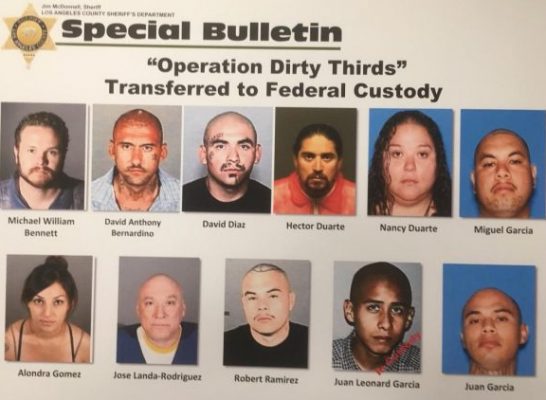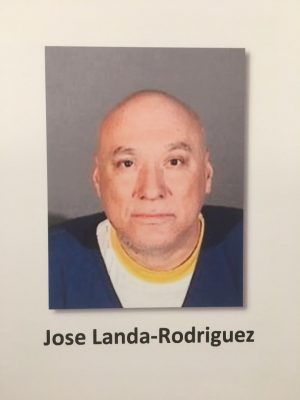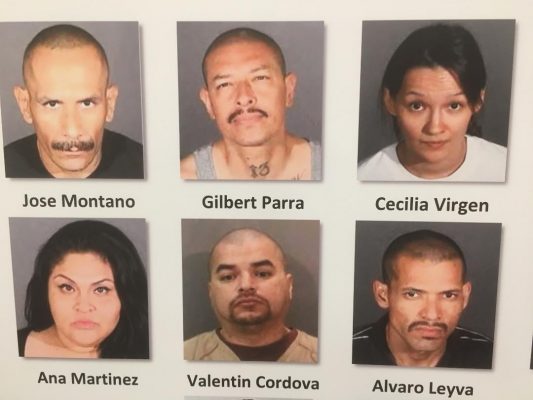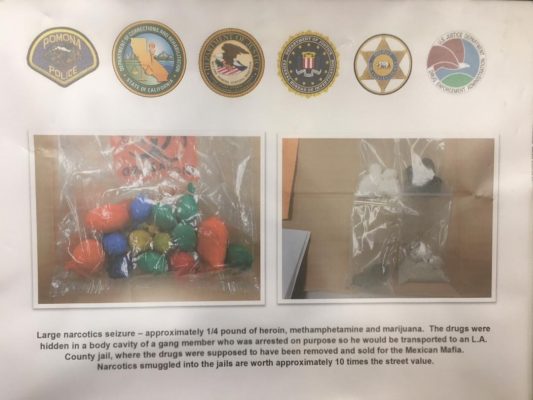Los Angeles has seen gang violence plummet in the last decade.
Some of the reasons why were on display in two federal criminal conspiracy cases announced this afternoon at a press conference at the L.A. office of the U.S. Attorney.
The cases involved the Mexican Mafia prison gang controlling drug taxation and trafficking in two places: The LA County Jail, largest jail in America, and in the city of Pomona.
The Mexican Mafia is a prison gang that runs the Latino gang members in the state’s prison system. About 25 years ago, it extended that power to the streets, ordering those gang members to tax neighborhood drug dealers and funnel the proceeds to MM members. Drug taxation thrives and amounts to the first regional organized crime system in the history of Southern California.
One case involved a Mafia member who controlled drug trafficking in the entire jail, according to the indictment: Jose Landa-Rodriguez, who grew up in East LA, a member of the South Los gang. He’s apparently been in county jail for many years, during the reign of the now deceased Lalo Martinez, a controversial MM member. Through those years, and after Martinez died, Landa-Rodriguez allegedly grew to control the drugs entering and for sale across the jail system.
Inmates not with the Mexican Mafia had to get his permission to sell. Only way to do that was by funneling a third of their product to the gang — hence the name of the case, Operation Dirty Thirds — then waiting while Mexican Mafia associates sold the stuff. That’s one way of controlling your competition. Violators were often beaten. That’s another.
They were helped, prosecutors allege, by Gabriel Zendejas-Chavez, a local attorney whom investigators say helped facilitate the trade, passed notes back and forth between Mexican Mafia associates, and that kind of thing. They were also helped by a slew of go-betweens who would get arrested with drugs in their bodies.
The other indictment involved a Mexican Mafia member named Mike Lerma, who has controlled Pomona for many years from his cell in solitary confinement at Pelican BayState Prison maximum lockdown. Crews of members from 12thStreet, Cherryville and Pomona Sur street gangs were working together under Lerma’s command, the indictment alleges. The indictment alleges Lerma’s crews did kidnappings, robberies, identity theft. These are Pomona gangs that have harbored animosity against each other for years, but have repressed the urge to go after one another due to orders from Lerma, according to officers I spoke with.
(Btw, I briefly met Mike Lerma one time, in his cell in Pelican Bay State Prison. We were separated by Plexiglass and he was cooking a cup of cocoa on his hotplate in his pale-yellow concrete cell where he spent 23 hours of every day. He was small, a wan and bent fellow, wearied by years on solitary confinement. From behind the glass, he waved, said how you doing? I said fine.)
The mafia’s system has forced gangs to abandon what made them local neighborhood scourges because it leads to unwanted police attention.
“Years ago, they were about turf,” said one. “Now they’re about protecting their business.”
For decades, they waged wars over turf. They defended street corners, parks, markets, apartment buildings like they actually belonged to them. They were very much street gangs, and their activity — graffiti, shootings, car jackings, simple hanging out through which they did their recruiting — blighted working-class neighborhoods across Southern California.
These days, though, they are absent. They have retreated into the shadows. Doesn’t mean they’re gone for good. Just that they’ve disappeared from the streets, no longer are out in public, damaging neighborhoods that can least afford it, spraying up mom-and-pop markets. Homicides are way down because gangs don’t have easy rival targets to shoot at. That’s one reason anyway. In Pomona, the once-notorious Sharkey Park – from which Pomona 12thStreet earned its name the Sharks (members often had shark tattoos) — hasn’t had a shooting in who knows how many years. Some Pomona cops at the press conference couldn’t remember the last one. As if to exorcise the past, the park has been renamed Tony Cerda Park, in honor of a Native-American activist and tribal leader; pow-wows are held at the park.
Gangs are just not evidence in Southern California. It’s a remarkable, profound change in culture and crime, and one that benefits cities, neighborhoods, and working-class residents most of all. Parks are once again places for kids to play. This is part due to dictates in the underworld, from organizations like the Mexican Mafia, who want their business protected.
But it’s also due to an unprecedented amount of collaboration among law enforcement. In the 1980s and 1990s, this didn’t exist. Agencies fought each other for credit, turf, budget, as the gangs grew fierce and brazen. But the last decade or more has seen a remarkable change and that too you could see at the press conference.
At the press conference, cops of all stripes assembled to thank each other for working together. The feds thanked the locals. The locals thanked each other and the feds.
“I want to give special thanks to our law enforcement partners,” said Pomona Police Chief Mike Olivieri.
(For the record, apart from Pomona PD, that includes the FBI’s San Gabriel Safe Streets Task Force, the LA County Sheriff’s Department, ATF, the DEA, Ontario Police Department, the IRS Criminal Division, the U.S. Immigration and Customs Enforcement’s Homeland Security Division.)
“Today’s action is not an isolated event. Southern California law enforcement is united in its fight against violent criminals and street gangs,” said U.S. Attorney Nick Hanna, continuing the theme.
I’ve been to a dozen of these gang-conspiracy press conferences and I always like it when they thank each other. Because it wasn’t always that way.
Speaking with a prosecutor outside the press conference, we marveled at the change and wondered how the trauma of the 1980s and 1990s might have been avoided had this kind of collaboration been more common


